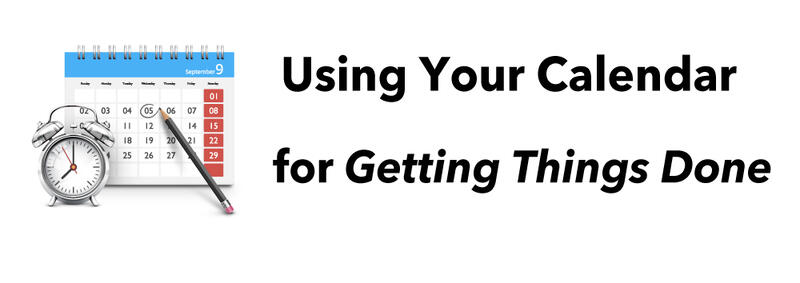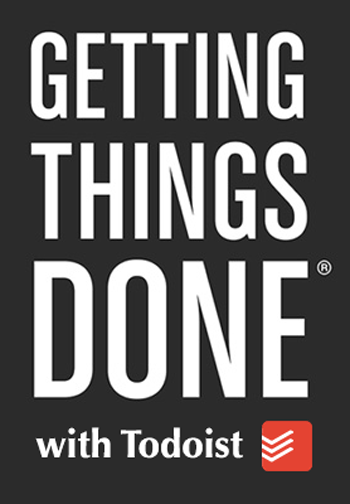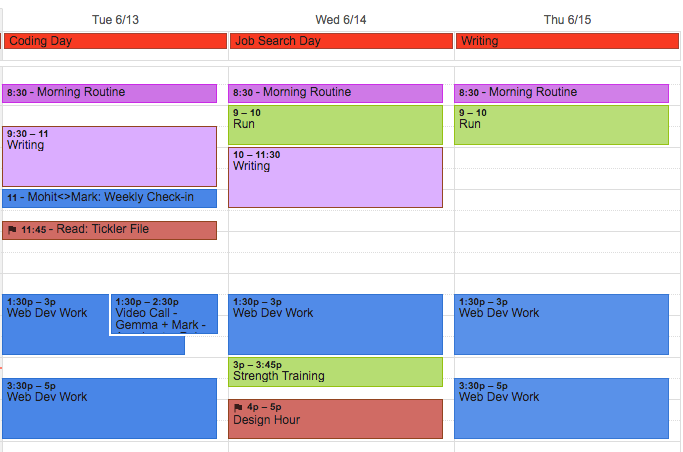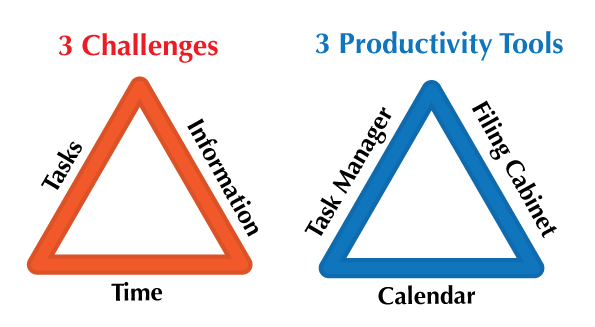
We all use our calendars to mark off meetings, events, due dates, and appointments. At its most basic, anything with a date and time should go in our calendar or agenda. Whether it’s a physical, paper calendar or its digital equivalent, a calendar is one of the important organizational, productivity tools.
Along with a dependable filing system for information and a good task manager, a calendar can help you work better. By having a process for organizing and managing your calendar, you can lower your stress, stay on task and gain more work-life zen.
For the modern, digital worker, if we exclude relationships, there are three key areas that we all struggle to manage effectively: information, tasks and time. We get stressed out dealing with information overload and distractions. We struggle to get a grip on all of our To-Do’s, priorities, projects and what’s next’s. And we all at some point feel like we don’t have enough time to get everything done. Everything is competing for our limited resources of time and energy, and we feel like we run out of time
Improving how we deal with our information, tasks and time can significantly improve our work and personal lives. While total mastery might be the goal and even if we can’t get there, we can get better. We can improve our processes and better equip ourselves to deal with these challenges.
The three cornerstones of a productivity toolkit are managing information, managing tasks and managing time.
In this post, I want to share how I manage my calendar. Specifically within the context of how things in general and specifically how I manage tasks and information already. For productive calendar usage the focus is on how I process time-dependent tasks, i.e. meetings, appointments, travel, etc. as well as how I structure and organize my time productively.
“Getting Things Done” Productivity Framework for Information, Tasks and Time

The book I recommend and give away most often is Paul Allen’s “Getting Things Done,” aka GTD. I’ve been an adherent to the GTD methodology for several years. I’ve written previously about how to handle your tasks and information within the GTD framework.
The GTD methodology is basically a way of thinking and organizing your “stuff.” Setup a clear logic and process and use tools and tech to handle it all. GTD promotes a clear system of task and knowledge management, so you can let your brain focus on work rather than remembering what’s next, due dates and your evolving to-do’s. GTD is less a “doctrine” than some useful tips and processes to take control over how we struggle information, tasks and time.
Personally, my productivity toolkit is equipped with the following: Evernote for my filing cabinet, Todoist for my tasks manager, and Google Calendar for my time-dependent appointments.
In “The GTD Way: Managing Your Tasks and Information with Evernote”[http://www.markwk.com/gtd-with-evernote.html], I explained the importance of a delegated process so you all your information and tasks have a place and your priorities stay on target. The bonus of this setup, as I shared in “How to Track the Articles You Read and Augment Your Digital Memory”, is that you also gain a system where all your key information, ideas and knowledge are searchable.

The key to getting things done is task management. We have too many things to do and remember to do. In (“Getting Things Done with Todoist”)[http://www.markwk.com/gtd-with-todoist.html], I updated my GTD philosophy since I started using a task manager called Todoist. Essentially all my tasks end up in various Todoist projects where I can prioritize and assign them to dates (and optionally times). The bonus of using Todoist, as I put it in (“Tracking Your Tasks with Todoist”)[http://www.markwk.com/task-tracking-with-todoist.html], is that I can track how many tasks I completed each week, including their priority and projects involved.
The final piece in my productivity toolkit is my calendar. Like a dependable information storage setup or a reliable task management system, a calendar is a way to organize things so you can focus on the important work and let your calendar handle the scheduling of it.
In the GTD framework, a calendar fills the gap for handling all things with a specific date and time. This means anything that has a specific time and date goes into your calendar.
We all deal with a lot “stuff.” The key to deal with it that stuff is to define what is and put it its proper system. When it comes to information, you store it your file cabinet either physically or digitally. When it comes to actionable items, you figure out what’s next to do and put it your tasks manager or agenda. When it comes to anything with a specific date and time, you put it in your calendar. It’s as simple as that. Get things out of your head and into their appropriate systems.
Like most people, I primarily use my calendar to mark off any time-specific events. Secondarily I use my calendar to block off and organize my time. My calendar is my way to organize my time and priorities. I can ensure my goals progress by blocking off focused chunks of timing. Let’s look at this in the next section.
“Chunking” or Blocking Off Focused Time for Your Priorities
Beyond thinking of your calendar as where you place events and appointments, your calendar can be an aid to being more productive. You do this by assigning focused blocks of time to work on certain activities. For example, I use my calendar to create specific blocks of time to focus on certain activities. This method is called “chunking” or “batching,” and it is a well-known way to optimize your productivity.
Rather than constantly switching tasks and mental modes, essentially you are able to get more done by focusing on certain related activities and tasks during a focused block of time.
It is a method where you avoid multitasking and focus on a specific area of work in a “block” or “time chunk.” Typically blocks are between 1-hour and 2-hours. But you might use bigger blocks of time and include breaks or even use the Pomodoro Technique of 25 minutes of work followed by a 5-minute break. Within these blocks of time, you focus on work that relates to that area.
For this to work, it’s important to know your priorities and roughly how much time each week you want to assign to these areas. So make sure you know your goals. You can’t get everything done, so the point is to make progress on your highest priority tasks and goals.
In my case, I have several goals and areas I focus on, and, as such, I have weekly blocks of time for work that include writing, business development, and finances, and web development. I also have blocks of time for running, strength training and even meditation.

When it comes to work, I assign tasks into these weekly blocks of time. My mind is able to relax in the present knowing that I’ve already planned time for different things. Once that block of time arrives, I’m able to focus on that area and work through related tasks. These chunks of time also create a mental habit where I don’t debate my priorities and simply work through my focused list of tasks accordingly.
For me these blocks of time are the cornerstone of ensuring I advance on my work and goals as well as have time for health and fitness. While these blocks might move, I note them in my calendar to ensure I’m putting in the time.
Theme Days: A Day for a Single Focus
Chunking has been another effective way to ensure I have focused blocks of times for my priorities. By putting minimal blocks of time in my calendar, I make sure these focal areas see regular progress.
Unfortunately with so many goals and priorities, a single day in my calendar can turn into a lot of competing interests, and my productivity might struggle during days where I try to write, do finances, manage a client, check-in with my team and code. I have focused blocks of time, but having too many focuses in a day can lead to distractions and burn out.
This is where “Theme Days” can help, an additional I recently added to my calendar. Theme Days are essentially all-day focuses. Like chunking or time blocks, a theme day is focused on a particular area or project. For me this might be writing, coding studies or a particular client project.
By focusing my attention and time on a single area, I’m able to get more done. Similarly I’m able to better schedule tasks. Instead of having scatter-brain, multitasking days, I take new tasks and assign them to the relevant theme day.
On the calendar I note theme days as all-day events and they appear at the top, making it clear my goal for that day.

Theme Days provides some mental relief from trying to figure out how I’ll squeeze in certain tasks on certain days. It also lets me have occasional project days that fall outside of my usual weekly agenda.
Theme Days might be weekly consideration or they might be later in the month or year. Having a specific theme day assigned a few weeks in the future can help you avoid overloading tasks in a week and leaving a grouping of tasks for that upcoming Theme Day. Either way theme days provide an added layer to prioritize and organize.
Obviously it’s not perfect and you can’t really avoid feeling like you aren’t getting everything done. But, like setting weekly objectives, theme days provide a framework for targeting what is most important for you in time.
Conclusion: Your Calendar and Your Tripartite Productivity System

I like getting things done, but I also like to avoid the stress and burn out that can come with attempting too much without a plan and a process. This is where Paul’s Allen’s “Getting Things Done” methodology can help. GTD helps us to figure out a clear process for dealing with the three big challenges of modern life: managing information, managing tasks and managing time.
In this post, we looked briefly at these three areas and three tools to helps us work productivity.
The goal is take all of life’s undefined “stuff” and bring it into a reliable system. This takes the stress and pressure off of your brain and memory. The result is organized knowledge, defined tasks and scheduled routines and time. You are relaxed self who can focus on the working. To accomplish this you need a tripartite productivity system an information system, a task manager and a calendar.
Your calendar can be more than where you put time-dependent tasks, like meetings, appointments and travel. It can also be where you carve out a realistic allotment of time for your projects, priorities and goals. If you don’t put in the time, then you can expect to see your dreams come true.
Some useful techniques are “chunking” and “theme days” which provide structured focus and grouped tasks. Both of these will help improve your efficiency and focus. But mostly chunking and theme days are a way to guard time for what matters.
While GTD and productivity practices in general might feel like more work, the reality is that they are just processes to help you avoid the bane of modern, information-heavy life. You should never spend more time on the systems than the work itself. That said, by figuring out what your rules are for managing the flood of information and tasks, you can get your best work done.
Your filing cabinet, your task manager and, of course, your calendar become your ninja weapons for dealing with the mess of modern, digital life.
Good luck and happy productivity!
